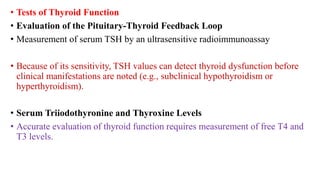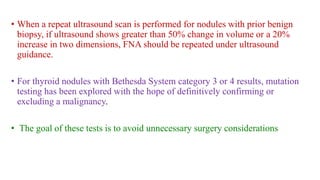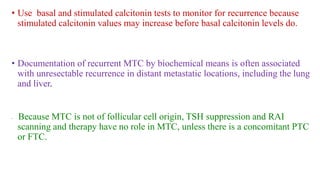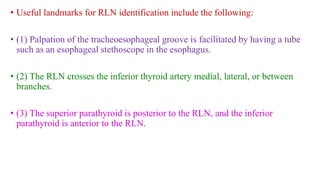This document summarizes thyroid diseases and evaluation of thyroid nodules. It discusses the peripheral action of thyroid hormones, thyroiditis conditions including Hashimoto's, subacute, and Riedel's, hyperthyroidism including Graves' disease and toxic nodular goiter, evaluation of thyroid nodules including risk factors and initial workup, and treatment options for hyperthyroidism such as antithyroid medications, radioactive iodine, and surgery.




![• Most T3 is peripherally derived from the deiodination of T4, which takes place
largely in the plasma and liver.
• Other deiodination processes are found in the central nervous system,
especially the pituitary gland and brain tissues, as well as in brown adipose
tissue.
• Peripheral conversion of T4 to T3 can be impaired in overwhelming sepsis –
malnutrition- propylthiouracil [PTU]) use- high-dose corticosteroids- beta
blockers- iodinated contrast agents, and amiodarone use resulting in thyroid
imbalance](https://image.slidesharecdn.com/thyroid-220122163556/85/Thyroid-5-320.jpg)
































































































































![• Treatment
• Patients with impending airway compromise frequently have very rapid results
with the initiation of chemotherapy, particularly the glucocorticoid component,
potentially avoiding the need for a surgical airway.
• Use of the CHOP regimen (cyclophosphamide, hydroxydaunomycin
[doxorubicin], Oncovin [vincristine], and prednisolone) has been associated
with excellent survival.](https://image.slidesharecdn.com/thyroid-220122163556/85/Thyroid-134-320.jpg)












































